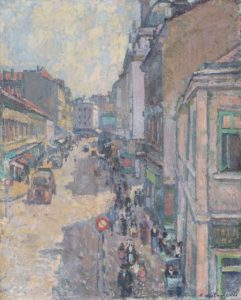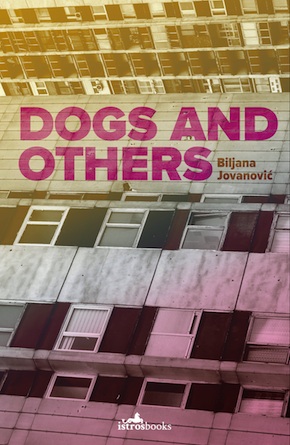A death in the neighbourhood
by John K. CoxBiljana Jovanović’s Dogs and Others is strong medicine. It depicts a young person’s attempt to ‘invent her childhood’ and ‘liberate her memory’ while she negotiates a bohemian, urban existence in Yugoslavia in the 1970s; it is more than graphic, and painful, and awkward at times: it is a tale of catastrophe, really and truly annihilating catastrophe – but also of great courage. The narrator, Lidia, is rigorously probing her often wretched memories of neglect from childhood, even as she tries vigorously to navigate humanely her complicated living situation in Zemun (in greater Belgrade) in the apartment of her long-gone mother, which she shares with her dying grandmother and her suicidal brother. But the author also shows great courage here. That is why Dogs and Others is the single most effective introduction to the oeuvre of Jovanović, an important Serbian novelist and dramatist who is almost completely unknown outside of her home country.
Jovanović died of cancer in 1996; she was only forty-three years old. In the novel at hand, a different death provides the climax of the story: the protagonist’s brother commits suicide in the shattering resolution of the dysfunctional relationships and emotional drift of the various characters. And, as Jovanović herself noted in interviews, the country of Yugoslavia, which was the setting of her works, in all their concrete, cacophonous, rebellious and tender glory, also died in the 1990s. It felt like the end of the world, to paraphrase the author; and it cut the lives of her generation in half: between the past, memory and nostalgia, and in the other direction, war and nothing.
Jovanović wrote in almost all major genres; she published four plays, three novels, two collections of letters and one anthology of poetry, as well as a sizable number of non-fiction pieces, mostly connected to her political activism. The popularity of her writings, especially her first two novels, has positioned her as a perennially beloved figure on today’s Serbian literary scene, even as her actual profile evolves from being a popular counter-cultural figure (even an author of ‘cult classics’) to more of a ‘writer’s writer’. As widely known, and rightfully admired as she is among intellectuals and activists for her work in civil society, she was also a talented and courageous writer of fiction and drama.
Growing up as the unsolved contradictions of the reign of Tito were emerging from the shadows, she is remarkable not only for her civil courage, but also for her intellectual perspectives and her rich and bracing writing.”
Jovanović’s family had Montenegrin roots and, although she was born in Belgrade, she maintained active ties to that part of Yugoslavia. Her father, Batrić Jovanović, was a military official and political functionary in Tito’s Yugoslavia; her mother was Olga Ćetković, a journalist; both parents had been Partisans during the Second World War. The youngest of three children, Jovanović enrolled at the University of Belgrade in 1972 and studied philosophy. She was an early and active member of a large number of important human rights groups in Yugoslavia, beginning in 1982. These groups were concerned with issues from the death penalty to the environment, and from artistic freedom to feminism. Two of her most famous engagements were with the Belgrade Circle and the Civil Opposition Movement, both in the 1990s, when she had to add anti-war activism to her earlier engagements for pluralism and justice. She was an organizer and participant in a number of major anti-war campaigns and events, and she helped found a ‘flying’ (underground) workshop (or university) in 1992.
 While working as an editor and proofreader, including at the prestigious journal Književne novine, she wrote three novels. These appeared in print in short order: Pada Avala (1978), Psi i ostali (Dogs and Others, 1980), and Duša, jedinica moja (1984). Her writing for the stage began in the 1970s and lasted through until the end of her life. Unfortunately, very little of her work is available in English. Since 2006 there has been a major literary prize in Serbia that is named for her, awarded by the prestigious Srpsko književno društvo (Serbian Literary Society), and there have recently been conferences, retrospectives, a noticeable increase in scholarly attention about her writing, and reprints of her works.
While working as an editor and proofreader, including at the prestigious journal Književne novine, she wrote three novels. These appeared in print in short order: Pada Avala (1978), Psi i ostali (Dogs and Others, 1980), and Duša, jedinica moja (1984). Her writing for the stage began in the 1970s and lasted through until the end of her life. Unfortunately, very little of her work is available in English. Since 2006 there has been a major literary prize in Serbia that is named for her, awarded by the prestigious Srpsko književno društvo (Serbian Literary Society), and there have recently been conferences, retrospectives, a noticeable increase in scholarly attention about her writing, and reprints of her works.
Whether Jovanović is, in the final analysis, considered primarily a pioneer of ‘jeans prose’, a feminist, a vulnerable and extremely sensitive but also powerful witness to nationalist, authoritarian and patriarchal anachronisms, a ‘rebel with a cause’ (as the title of the major anthology released on the 20th anniversary of her death reads in translation), an avant-garde experimentalist, a chronicler of the Yugoslav socialist experiment, or all of the above, her prose is both descriptive and normative in new ways. Jovanović was growing up as the unsolved contradictions of the reign of Josip Broz Tito and the League of Communists were emerging from the shadows of the anti-fascist moment and the Cold War. In the opinion of this translator and historian, she is remarkable not only for her civil courage, but also for her intellectual perspectives and her rich and bracing writing.
Dogs and Others is a quest. It is built of a spare plot much enriched by flashbacks and letters of various types. The glue that holds its pieces together is a particular epistemology, more or less articulated in various barely-disguised authorial interventions sprinkled throughout the text(s), along with a pell-mell, ‘take-no-prisoners’ style of narration that is well suited to capture the tumult of Lidia’s life and surroundings. And the whole thing ends up feeling like an acid bath. Everything is stripped of its facade or patina, all paradoxes melt away, and we are left with excruciating truths about power and loss. Only pain survives this book. We can hope our vision is a bit sharper, too.
The novel is, to say the least, highly unconventional. ‘Avant-garde’ is a better characterization. It is set in Belgrade in the 1960s and 1970s, and through a fragmentary narrative replete with intertextuality and interior monologues (‘stream of consciousness’), the lives depicted in the novel are probably more ‘counter-cultural’ than ‘bohemian’ per se, but above all they are modern and urban. Lidia’s family life is pulling apart at the seams due to old age, disability, mental illness, drug use and suicide; her very personhood is also bedevilled by memories of an abusive childhood that are still very much alive, but also by sexism, sexual harassment, and sexual assault in her adult world. Lidia is raped by her psychiatrist and sexually assaulted by her boss; her love Milena is assaulted by her dentist and, in turn, sexually assaults an intellectually disabled patient in her care.
The reader, breathless and sometimes even partially blind, is hurtled through the story and plunged into situations awash in carefully calibrated amounts of what seem to be random detail and suffering.”
A kind of frame tale is set up in the first chapter, with the narrator and her baba (grandmother), Jaglika, positioned to complete each other’s stories about the history of the family. The narrative is constantly disrupted by the unexpected appearance and disappearance of characters, by the insertion of a group of detailed and disturbing letters from an anonymous neighbour, by often unmoored ‘Images from Childhood’, and by frequent use of words such as ‘the others’, ‘the rest’, ‘all’, and ‘everything’. In addition, the author takes an experimental approach to punctuation, spelling, paragraph structure, attribution, epigrams, chapter titles and, of course, chronology, so that the reader, breathless and sometimes even partially blind, is hurtled through the story and plunged into situations awash in carefully calibrated amounts of what seem to be random detail and suffering. The novel works hard, and it works the reader hard, but with great effect.
The death of Lidia’s brother, mirroring that of her father, casts her progress in trying to understand her world into doubt, if not into a nosedive. The novel even closes with a reference back to the cryptic preface of the book, underscoring the bleakness of the burden of self-assertion and social adaptation.

Knez Mihailova Street by Milo Milunović, 1938. The Pavle Beljanski Memorial Collection/Google Arts & Culture
Translators read books multiple times, and they do so very carefully. For this reader, some of the most memorable scenes in the book involve Jaglika, the baba. She is a kind of unifying or intersecting axis across multiple generations and ethnicities, and parts of her life story also appear in other places in Jovanović’s fiction. The apartment in which most of the family lives, although only partially described, is the site of a wondrous number of comings and goings; it’s located in an out-of-the-way part of greater Belgrade, but the number of visitors, all seeking different things – from trysts to funeral visitations to porn screenings to jobs and lodgings and beyond – make it a microcosm of the urban world. The way Jaglika’s physical decline is charted, and the interactions of her family members in its shadow, is thought-provoking and disarmingly unconventional. The impact of two startling incidents in Belgrade trams or buses, one involving Lidia and the other her brother, endures in a cinematic style, long after reading.
Some of the appeal of this novel to historians, or to people from the western Balkans, might stem from the reality of local life that populates the narrative. These ‘assemblages’ of Yugoslav products and practices range from cafe fare (tulumba, krempita, boza) to UNICEF greeting cards and specific consumer items such as rice, soap and bleach, and from summer vacations in Italy and Istria and reading circles to Sunday family strolls along Knez Mihailova in downtown Belgrade. We are also on the edge of the world of books and literature and universities when we are in Lidia’s world: there are libraries, class notes and handouts, and references to Dostoyevsky, Balzac, Castaneda, Dewey, Bergson, Schopenhauer and Mann. The relationship between Lidia and Milena is tracked fearlessly from attraction through sex to toxic arguments. Some of these passages are startlingly evocative in the service of emotional and physical connections; some of them are flat-out beautiful, in a very modern way.
This book takes us from a scene in which a mother, flashing ‘encoded family glances’ and telling a grandmother ‘This child’s never going to stop lying. We’re taking her to the doctor’ to a daughter longing for the chance to acquire explosives from the Red Brigades in Italy and blow her mother’s head off. That’s what was meant back in the opening sentence of this essay about ‘strong medicine’. It is a novel, one could say, of backbiting and recrimination that gives way to excavations of mental and physical abuse and sexual violence and more, and ends in full-blown social critique.
In style and impact, perhaps an analogue to Dogs and Others might be found in the compelling novels of the British Nobel Prize laureate Doris Lessing (1919–2013) or the Quebecois novelist Hubert Aquin (1929–1977); many other comparisons to writers outside the South Slavic sphere are doubtless possible. In addition, Yugoslavia never lacked for hard-hitting and inventive authors, in any epoch. But within Serbian literature, it would be hard to find, even at the late date of her writing within the trajectory of Yugoslavia, a writer who carried a bigger set of thematic and political concerns into innovative texts. And, in terms of women writers, Jovanović arguably joins Judita Šalgo (1941–1996) and Milica Mićić-Dimovska (1947–2013) in the vanguard of challenging and accomplished artists.
As this translation went to press, the #MeToo movement was over a year old and still growing in social and political importance. It is impossible not to notice the amount of sexual harassment, abuse and assault in this novel, which itself is 38-year-old evidence in a millennia-old struggle for voice and redress. It is not too much to ask that we stay open to questions asked by older novels. And this is true also about the reception accorded to innovative or transgressive writings. Therefore, over time, it is quite possible that the study of Jovanović’s novels and their real-life trajectories will tell us a lot about what life was like in socialist Yugoslavia and what went wrong with Titoism.
Adapted from the afterword to Dogs and Others (Istros Books, £9.99)
 John K. Cox is a professor of East European History at North Dakota State University in Fargo. He earned his PhD from Indiana University-Bloomington in 1995 and specialises in modern Balkan and Central European intellectual history. His translations include works by Danilo Kiš, Miklós Radnóti, Muharem Bazdulj, Ivan Cankar, Radomir Konstantinović, Stefan Heym, Goran Petrović, Ismail Kadare, Ajla Terzić and Vesna Perić. He is currently translating other works by Biljana Jovanović as well as novels by Dragana Kršenković Brković and Erzsébet Galgóczi. His translation of Dogs and Others is out now in paperback from Istros Books.
John K. Cox is a professor of East European History at North Dakota State University in Fargo. He earned his PhD from Indiana University-Bloomington in 1995 and specialises in modern Balkan and Central European intellectual history. His translations include works by Danilo Kiš, Miklós Radnóti, Muharem Bazdulj, Ivan Cankar, Radomir Konstantinović, Stefan Heym, Goran Petrović, Ismail Kadare, Ajla Terzić and Vesna Perić. He is currently translating other works by Biljana Jovanović as well as novels by Dragana Kršenković Brković and Erzsébet Galgóczi. His translation of Dogs and Others is out now in paperback from Istros Books.
Read more
@Istros_books
Author portrait © Jon Solinger
Read an extract from Dogs and Others


